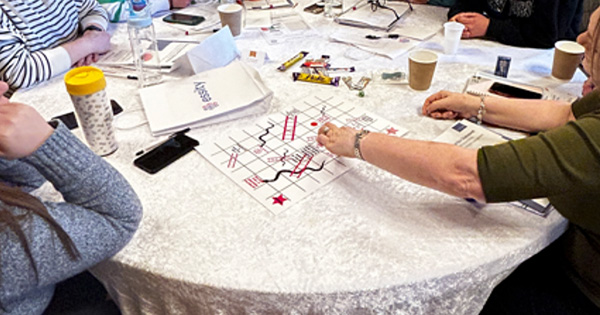During ‘lockdown’ many people became familiar with the use of Quick Response or Quick Read ‘QR’ codes to link to menus and order food and drinks in bars and restaurants. The QR code, initially developed for the automobile industry, is more useful than a bar code, enabling people to link directly to a website, document or multimedia file (Kubben, 2011). The rise of smartphones has made QR codes easy to use by the general public, as well as in healthcare. QR codes have been adopted in many aspects of healthcare, including patient wristbands, test tubes and biopsy reports, all of which can contribute to increased patient safety (Shakil et al, 2014). QR codes have been used by the Tissue Viability service at the Royal United Hospitals Bath NHS Foundation Trust (RUH) to link to videos in patient safety information (Arrowsmith et al, 2021). This quality improvement project offered hospital inpatients access to information about pressure ulcer (PU) prevention, with the QR code directing patients to an informative video.
Like other trusts, the Tissue Viability service have produced resources to guide clinical practice for a number of years. These resources support healthcare professionals in clinical practice, for example, when assessing specific wound types such as skin tears or when guiding the referral of specific wound types, such as leg ulcers. Traditionally, these were printed paper resources, however this practice was problematic in terms of keeping paper copies up-to-date, and repeatedly printing documents was not in line with the Trust’s sustainability value. These same resources were later stored on the Trust’s intranet site, meaning that staff were able to view wound care pathways and protocols when clarification was needed. However, although this was better from a sustainability perspective, it was difficult for staff to access an available computer, and searching for the relevant documents was time consuming and impractical when working on a busy ward.
Method
The Tissue Viability Team worked with the trust’s web team to produce QR codes for each of the tissue viability pathways. This would enable health professionals to access the information they needed on their smart devices. Once each document was assigned a QR code, the codes were compiled onto a single A4 page and divided by category to allow easy navigation (Figure 1).
The use of QR codes to access these clinical resources is the latest innovation at the RUH to enable staff to have the clinical assistance they need quickly and seamlessly guiding clinical care. This ‘QR code bank’ is an A4 printed and laminated sheet of QR codes for all of the tissue viability guidance and protocols (Figure 2).
Clinicians can scan the QR codes from their smart phones or devices and have instant access to the information which they need. This has been tested using PDSA methodology (Deming, 1986; Langley, 1996: NHS England and NHS Improvement, 2022; Figure 3). Table 1 outlines the process which was used to trial and improve the new QR code bank.
Plan
Having identified a problem following feedback from ward staff, the Tissue Viability team’s objective was to explore who needed the information, how it was needed, and how they could most effectively enable prompt access to the information that was required. It was agreed that QR codes appeared to be the best method. Once the decision had been made the team conducted research into whether this would be possible, liaising closely with the Trust’s web team and digital nurse to gain insight into how this could be achieved and what funding would be required, if any. Additionally, the idea was discussed opportunistically with nursing staff about whether this might be something they would find useful. All feedback at this stage was positive.
Do
The Tissue Viability team then needed to decide how much information should be included. Wound care protocols and policies were reviewed by the team and, once agreed upon, the relevant documents were sent to the web team to be uploaded onto the Trust’s internet site. Hyperlinks were created to allow access to the documents and used to generate QR codes. These were compiled and the posters created.
Some draft QR codes were created and tested by members of the Tissue Viability team. A sample poster was created and taken to wards where it was informally shown to members of the nursing team and their opinions sought. It was important to discover whether it would be used and if it would be helpful.
The next step was to gain feedback. Wards were approached and asked to consider a trial. Of those that agreed, one medical ward was selected and given a poster for a short period before being asked for feedback.
Study
The response from the initial trial was overwhelmingly positive. There were no changes required, as any teething problems had been resolved before the beginning of the trial, so the decision was made to roll the QR posters out across more wards. Following a continued positive reaction the posters have now been distributed across the trust.
Following the roll out across the trust, it became apparent that certain areas, including the Emergency Department and Paediatric departments, required a specialised version of the poster to enable them to access information most relevant to their areas of expertise.
Act
As a result of the most recent feedback, further QR code posters were developed to support specialist areas. Subsequently, feedback has been positive, and this will be reviewed periodically.
It is noted that the posters will require updating as protocols and formularies evolve and it is expected that the posters will be replaced at least annually to ensure that ward staff continue to receive up-to-date information, enabling them to deliver gold standard care.
Results
The initiative has been well received by clinical staff across the trust. The QR code bank has proven to be particularly useful for staff new to the trust who may still be familiarising themselves with RUH guidance. Additionally it has been a useful way for new staff to familiarise themselves with the RUH dressings formulary. Feedback from ward staff has been collected, see Table 2.
Limitations
There are many apps and websites available that enable users to generate QR codes, and while many of these are free at the point of creating a code, subscriptions are required to enable account holders to monitor the usage (or number of “hits”) for each QR code. There was clearly value in this data collection. Showing how frequently the posters were used would have enabled the tissue viability team to monitor how well the posters were being received on the wards Additionally, it was recognised that, if particular protocols were being accessed more frequently (for example, the leg ulcer protocol), this may highlight a trust-wide training need to which the team could respond.
Having looked at various subscriptions, the tissue viability team realised there may be difficulties in acquiring an account that would be suitable for use across the trust due to the number of staff who would eventually need to access it, should the concept be rolled out across other departments. It was therefore decided to continue the project using the free codes that the websites offered and rely on verbal feedback from staff following their distribution across the wards.
Since the posters were launched, they have been so successful that the trust is keen to broaden their use and are continuing to research ways in which accounts can be set up to enable auditing of the QR code usage and how they may be used to further benefit patients as well as staff.
Conclusion
The project has successfully helped busy ward staff to access the resources that they need in a timely fashion. The impact on patient care is difficult to measure, however ward staff report they are able to deliver gold standard care more quickly and efficiently with the QR code bank. There has been a great deal of interest in the QR code bank within the trust from other services such as the infection control and falls teams. Additionally, external companies who have learned of the project have expressed interest in the process behind it, with a view to implementing a similar system, thus enabling clinicians to access their resources in a quicker and easier way. The PDSA methodology allowed the project to be implemented in a systematic way, allowing small scale changes to be made before it was rolled out further. This meant that the final result was a carefully considered response to a problem and, as a result, more user friendly than if the PDSA tool had not been used.






